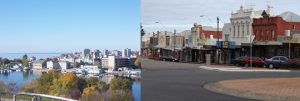Melbourne and Sydney Go Head to Head in Commercial Property Supremacy Battle
Melbourne and Sydney are often viewed as two competing cities. However, where commercial property is concerned, these two cities are actually more alike than people think.
Granted, Melbourne and Sydney are geographically different, but the two cities’ Central Business District have about the same available space, with Melbourne coming in at 4.7 million square metres, and Sydney at 4.9 million sqm. Another notable similarity is the commercial vacancy rates, with Melbourne CBD at 8.5%, and Sydney CBD at 8.4% as of June last year.

Rental quotes in Melbourne are usually computed on a net basis, while it is often quoted on a gross basis in Sydney. Both cities are experiencing a significant growth in population surrounding CBD districts – this resulting from elevated levels of high-density accommodation, some of which being converted older commercial and industrial buildings.
Newer developments, on the other hand, have been created to take off village-like communities, with ground floor retail space serving to cater to the building’s residents. While this is more commonly found in Melbourne, Sydney is quick to catch up and has adopted this style of development in the last 3 to 5 years.
Melbourne and Sydney both have prime retail strips which may be considered as destination shopping areas. These have high rents, low vacancy rates, and a strong and steady following. The constantly-increasing number of residents in these areas contributes to the popularity of the strips and its capacity to command strong rents. Yields of up to 4-5% can be expected in well-located property along these strips, with others that need further development raking in yields below 4%.
The biggest amount of vacant industrial land belongs to Melbourne, with Sydney coming in second among all of Australia’s capital cities. Both cities enjoy stable industrial markets alongside limited capital growth. As this is the case, returns are sourced from rental yields, ranging from 7% for prime assets to 10% up in lower quality assets. However, even if yields for these two cities are comparable, the higher rental rates ($30 to $50 per square metre higher) in Sydney results in higher capital values there.
Growth spots may also be seen in both major cities, close to ports and airports. Examples are Port Melbourne, and the Port of Botany expansion in Sydney.
In terms of size and activity in commercial property markets, Melbourne and Sydney showcase a lot of significant similarities. This is why investors need to stop focusing on cities in its entirety, and instead consult with a Sydney or Melbourne business broker to check out individual properties and look at them independently to see how strongly they can prove sustained growth.



